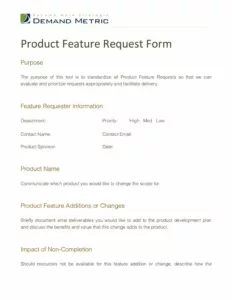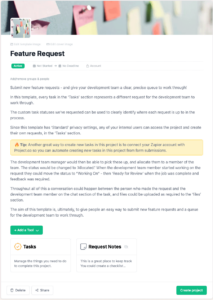Utilizing such a structure offers several advantages. It streamlines the feedback process, reducing ambiguity and saving time for both users and the development team. Clearer communication leads to a better understanding of user needs, resulting in more relevant and impactful updates. Furthermore, a standardized format allows for easier tracking and management of feature requests, contributing to a more transparent and responsive development cycle.
This structured approach to feedback is essential for continuous improvement and fostering a collaborative environment between users and developers. The following sections will delve deeper into the key components of an effective structure and explore best practices for submitting compelling proposals.
Key Components of a Feature Request Structure
Effective feature requests require specific information to ensure clarity and facilitate efficient processing. The following components contribute to a well-structured proposal:
1: Title: A concise and descriptive title summarizes the requested functionality. Brevity and clarity are crucial for quick comprehension.
2: Description: A detailed explanation of the desired feature, including its purpose and functionality. Specific use cases and examples strengthen the description.
3: Problem: A clear articulation of the problem the feature aims to solve. This helps demonstrate the value and necessity of the proposed enhancement.
4: Proposed Solution: A detailed outline of the suggested solution, including technical considerations and potential implementation approaches.
5: Benefits: A description of the positive impacts the feature would have on users and the platform. Quantifiable benefits are particularly persuasive.
6: Alternatives Considered: A brief discussion of alternative solutions considered and why the proposed solution is preferred. This demonstrates thorough consideration of the issue.
7: Visual Aids (Optional): Mockups, diagrams, or wireframes can help visualize the proposed feature and enhance understanding.
8: Priority: An indication of the request’s urgency or importance. This assists in prioritization and resource allocation.
These elements provide a comprehensive framework for conveying feature requests, ensuring they are well-defined, justified, and easily understood by development teams.
How to Create a Notion Feature Request Template
Creating a standardized template for Notion feature requests promotes efficient communication and facilitates effective development. A well-structured template ensures clarity and consistency, enabling development teams to understand and prioritize user needs.
1: Template Creation: Within a Notion workspace, a dedicated page or database template serves as the foundation for feature requests. A database offers enhanced organization and filtering capabilities.
2: Property Definition: Essential properties within the template capture critical information. These properties typically include “Title,” “Description,” “Problem,” “Proposed Solution,” “Benefits,” “Alternatives Considered,” “Visual Aids,” and “Priority.”
3: Property Type Selection: Appropriate property types ensure data consistency and enable efficient sorting and filtering. “Title” utilizes the “Title” property type, “Description” uses “Text,” “Priority” might use “Select” or “Multi-Select,” and “Visual Aids” can leverage the “Files & Media” property type.
4: Template Duplication: Users duplicate the template for each new feature request, populating the properties with relevant information. This ensures consistent formatting and facilitates efficient processing.
5: Submission Process: A clear process for submitting completed requests is essential. This might involve designating a specific page or database for submissions or integrating with other project management tools.
6: Template Refinement: Periodic review and refinement of the template based on user feedback and evolving needs ensure its continued effectiveness. This iterative approach promotes continuous improvement.
A dedicated template within a Notion workspace streamlines the feature request process, enhancing communication and enabling development teams to effectively address user needs. Structured information capture and consistent formatting contribute to a more organized and efficient workflow, fostering a collaborative environment for continuous improvement.
Standardized structures for submitting enhancement proposals offer significant advantages for both users and development teams. Clear communication, facilitated by structured templates, ensures efficient processing and prioritization of incoming suggestions. Well-defined fields for describing functionality, benefits, and use cases contribute to a shared understanding of user needs. This structured approach fosters transparency and responsiveness throughout the development cycle, leading to more impactful updates and a stronger user-developer relationship.
Effective implementation of these structured templates is crucial for maximizing their potential. Continuous review and refinement based on user feedback and evolving needs ensure the template remains a valuable tool. Adopting such practices contributes to a more collaborative and efficient development environment, driving continuous improvement and innovation within the platform.


